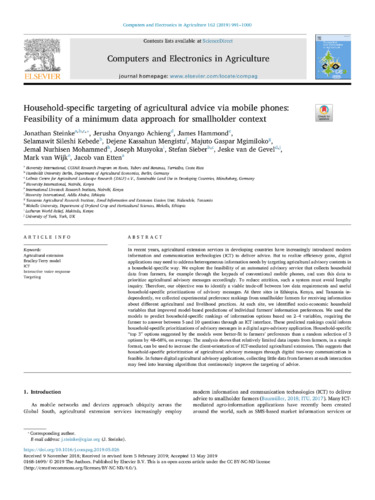Household-specific targeting of agricultural advice via mobile phones: Feasibility of a minimum data approach for smallholder context
In recent years, agricultural extension services in developing countries have increasingly introduced modern information and communication technologies (ICT) to deliver advice. But to realize efficiency gains, digital applications may need to address heterogeneous information needs by targeting agricultural advisory contents in a household-specific way. We explore the feasibility of an automated advisory service that collects household data from farmers, for example through the keypads of conventional mobile phones, and uses this data to prioritize agricultural advisory messages accordingly. To reduce attrition, such a system must avoid lengthy inquiry. Therefore, our objective was to identify a viable trade-off between low data requirements and useful household-specific prioritizations of advisory messages. At three sites in Ethiopia, Kenya, and Tanzania in-dependently, we collected experimental preference rankings from smallholder farmers for receiving information about different agricultural and livelihood practices. At each site, we identified socio-economic household variables that improved model-based predictions of individual farmers’information preferences. We used the models to predict household-specific rankings of information options based on 2–4 variables, requiring the farmer to answer between 5 and 10 questions through an ICT interface. These predicted rankings could inform household-specific prioritizations of advisory messages in a digital agro-advisory application. Household-specific “top 3” options suggested by the models were better-fit to farmers’preferences than a random selection of 3 options by 48–68%, on average. The analysis shows that relatively limited data inputs from farmers, in a simple format, can be used to increase the client-orientation of ICT-mediated agricultural extension. This suggests that household-specific prioritization of agricultural advisory messages through digital two-way communication is feasible. In future digital agricultural advisory applications, collecting little data from farmers at each interaction may feed into learning algorithms that continuously improve the targeting of advice.

